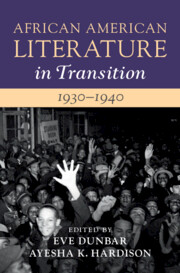Book contents
- African American Literature in Transition, 1930–1940
- African American Literature in Transition
- African American Literature in Transition, 1930–1940
- Copyright page
- Contents
- Figures
- Contributors
- Preface
- Chronology, 1930–1940
- Introduction
- Part I Productive Precarity and Literary Realism
- Part II New Deal, New Methodologies
- Part III Cultivating (New) Black Readers
- Part IV International, Black, and Radical Visions
- Index
- References
Introduction
Published online by Cambridge University Press: 25 March 2022
- African American Literature in Transition, 1930–1940
- African American Literature in Transition
- African American Literature in Transition, 1930–1940
- Copyright page
- Contents
- Figures
- Contributors
- Preface
- Chronology, 1930–1940
- Introduction
- Part I Productive Precarity and Literary Realism
- Part II New Deal, New Methodologies
- Part III Cultivating (New) Black Readers
- Part IV International, Black, and Radical Visions
- Index
- References
Summary
This introduction outlines the parameters of the 1930s as the decade that shapes the African American literature tradition. It considers the volumeʼs chapters and their willingness to linger in the economic, social, and political uncertainty – the transitions – that mark this oft-overlooked decade. Bound not simply by a willingness to grapple with cultural works produced during national and international economic, political, and social upheaval, this introduction argues for the decadeʼs centrality to the later twentieth-century literary trends in the form of literary concerns and aesthetic innovations.
- Type
- Chapter
- Information
- African American Literature in Transition, 1930–1940 , pp. 1 - 30Publisher: Cambridge University PressPrint publication year: 2022

